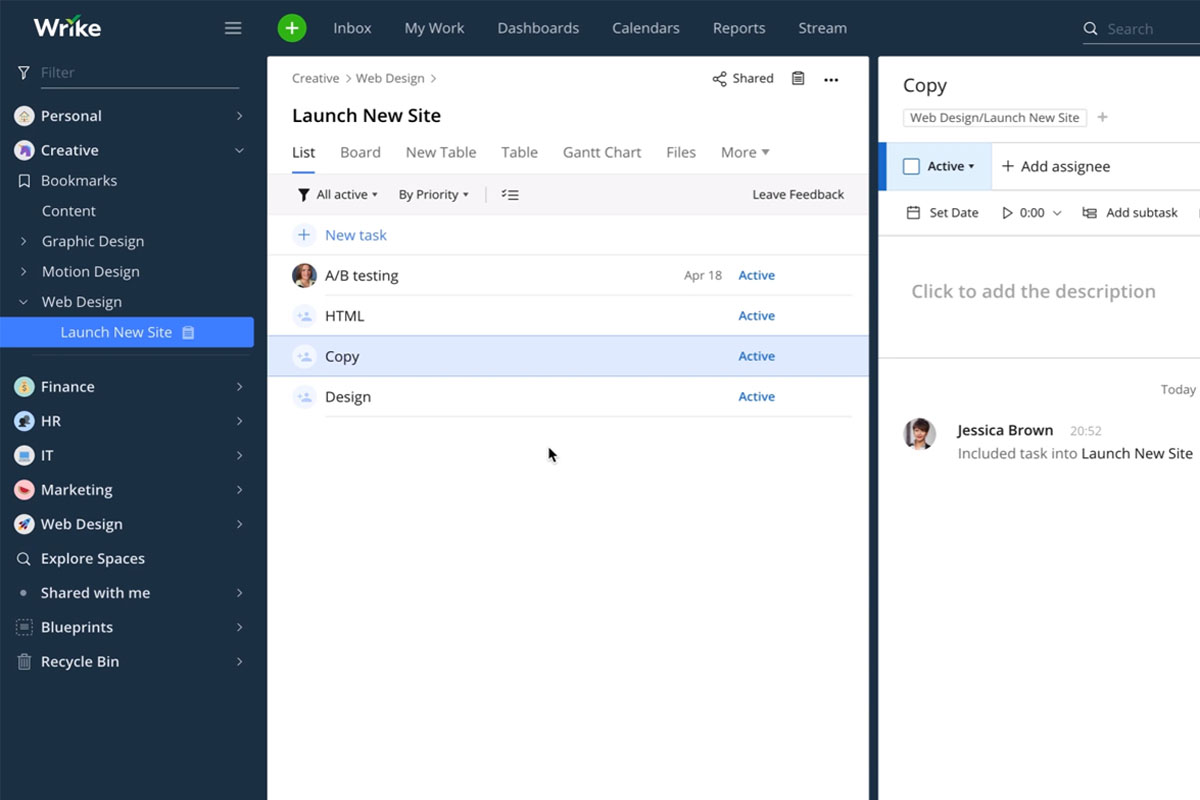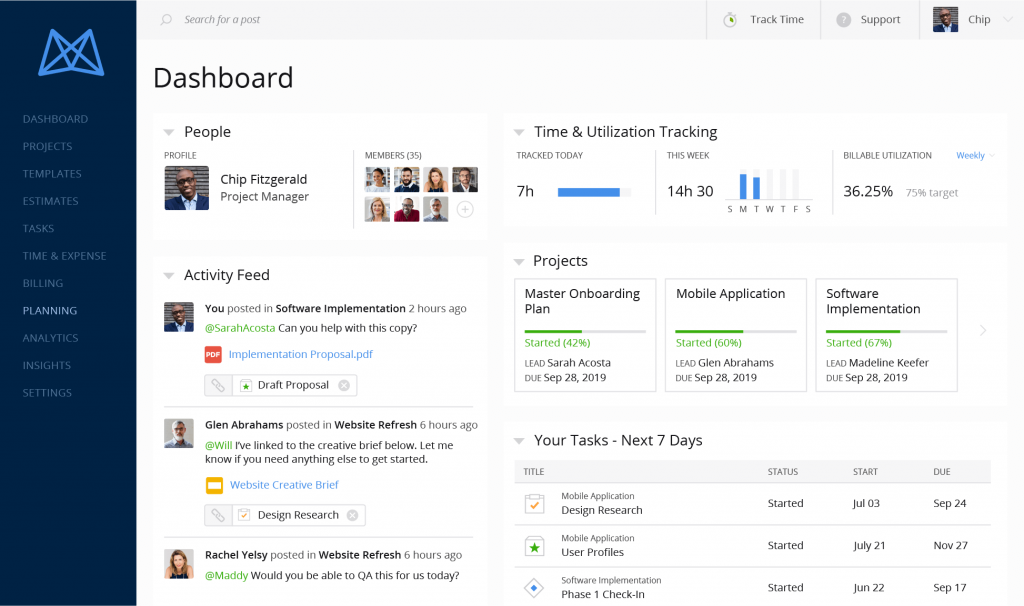Project management software is a suite of tools that helps improve production teams’ efficiency. They usually come as cloud-based, multi-user platforms that host features such as project planning and scheduling, collaboration, advanced reporting, and project budgeting, among many others. They are meant to ensure that all project stakeholders are constantly in the know and that every project is delivered on time.
The COVID-19 pandemic has disrupted many business processes that require face-to-face interactions, and project management is one of them. Despite the establishment of remote work and distributed teams, many project managers are still required to hold physical meetings. And then there is the challenge of bringing project team members together in different geographic locations. To mitigate this problem, 85% of businesses have accelerated digitalization.
Here, we’ll show you how project management software works and its general definition, this article will teach you more about its types, features, and what you can expect from it in the post-pandemic future.

Project Management Software Guide Table of Contents
The COVID-19 pandemic has impacted a diverse list of business sectors. The changes brought about by the pandemic have prompted businesses to rethink their approach to project management. These include the adoption of new technologies such as project management software, refocusing infrastructure, and upgrading existing systems. However, these may not be enough if companies are to retrofit their project management approach post-pandemic.
Source: GlobalData
The first order of the day is to reskill/upskill project managers. This will not only be beneficial to businesses but also to project managers. As could be expected flexible working conditions should become a mainstay of the project management landscape. The acceleration of flexible working at the onset of the pandemic has enabled many companies to recognize their benefits—reduced costs, better employee life-balance, and ensuring protection against the disease.
What Does Project Management Software Do?
We’ve described what is project management software earlier in the article, let’s now consider its key features. Some of the best features revolve around the generation of repetitive and unique tasks and projects, team collaboration, project completion, proper tracking for the purposes of budgeting and due diligence, and effective documentation. But that’s par for the course for most applications in the market. What are the most important features you should expect from a reliable solution? Here’s what we think is crucial:
- Project tracking. This is the most basic function of a project management software: tracking your projects. This includes being able to track who worked on which task last, the general overview of the entire project, identifying bottlenecks, and identifying performers.
- Easier collaboration. This is another goal of project management software. It makes it easier for coworkers to check on the latest changes to a project, pick up where they left off, or pick up from where their colleagues left off.
- Better communication. Part of the collaborative effort involves better communication, and the best project management software should make person-to-person and department-to-department communication easier and more efficient.
- Documentation. Since tracking a project involves documenting the knowledge gained throughout the entire endeavor, proper documentation is key. This means your app should be able to help you and your team simplify the process of documenting changes, technology, project updates, and new intelligence.
- Accurate dashboards for reporting. This is an important purpose of project management software. Accurate reporting is a key component of identifying your company’s KPI, and project management software should help you in generating the best reports for your business. They even give you the option of setting up dashboards if you want a quick look at how you’re currently doing.

monday.com’s project dashboard centralizes all communication and collaboration in one location.
What Are the Types of Project Management Software
We’ve defined what is project management software, but how does it work? Or more specifically, what are the various types of these solutions, and how do they function? There are several variants, and the categories are divided mostly by the installation location of the application, or the intended size and utilization of the app.
On-Premise – These are solutions installed locally into your company’s servers. This means that, barring special circumstances, access to the system is restricted to devices connected to your local servers. You can also call these apps locally-hosted project management software.
Some examples: JIRA and Microsoft Project
Cloud-based – These are basically project management apps that are hosted on cloud servers, which means that your users and your clients can access their projects wherever they may be, usually through a web browser. Cloud-based apps can also include some individual project management software and some on-premise options also have web-based versions too.
Some examples: monday.com, Wrike, Asana, Podio
Individual – For those of you with a very light need for project management solutions, or those who want to test the waters before diving in, an individual software will be just the right fit. These systems are web-based and lightweight, meaning they won’t be as feature-laden as other, more complete applications, but will be simple and straightforward enough for any individual to understand.
An example: Trello
Open API – These types of project management software provide their end users with the capacity to add to the already existing application. They can be great for those of you who have an app that you like, but would like to adjust a little bit to suit your preferences. These apps can also give you greater freedom in setting up your projects, since you can adjust components to suit your specific business needs.
Some examples: Clarizen, Trello

Clarizen’s dashboard gives a snapshot of each department’s project contribution.
Why Use a Project Management Software?
You’ve learned what is project management software but do you know what it can do for small, medium, and large enterprises exactly? Such solutions will mostly address a lot of concerns in the middle management, and will be a vital component in keeping an eye on the general key performance indicators of your company. This means that ensuring your projects, each one a unique venture on its own, are properly and efficiently completed. Here are some of the key features of a reliable project management software you should keep in mind:
- Real-time collaboration – Project management software should be great collaboration tools because is can give users the capacity to work in collaboration with each other in a shared space—without sacrificing each user’s focus. This means that teams can focus on their own individual projects, team leaders working on multiple ventures can keep an eye on multiple projects, and managers can stay on top of everything as things happen, without affecting other’s productivity.
- Sharing documents – Part of the real-time collaboration feature is the ability to share and work on documents with other members of your team. This can be made easier with project management solutions that allow you to integrate third-party cloud storage apps into the system, making long-distance collaboration a simpler endeavor.
- Cost management – One of the biggest challenges faced by project managers is accurately predicting costs, and mitigating them. Project management solutions should provide their users with accurate reporting options that can aid in cost projection, identifying sources of excess cost, and streamlining the production schedule to address any current and potential cost issues that may be present.
- Reporting – Efficient cost management wouldn’t be possible without the help of reliable reporting. A good project management software gives its users the ability to adjust their report formats. This means that you can streamline and include only the data that you need for a specific set of milestones. This capability will be instrumental in identifying the proper KPIs in a project, and can be key in identifying positive and negative components.
- Ease of use – Since the goal of project management software is to make the entire endeavor easier for all of its users, most, if not all, project management solutions available in the market are easy to use and easy to understand. Each one boasts a different design and UI from each other, but the general thrust is towards making the dashboard and options intuitive and simple to master.
- Easier Documentation – In connection with easier collaboration, project management software make documentation easier as well. This means that projects can be used for analysis and re-implementation in the future, and the solutions provided by previous teams can be implemented by other teams in future projects.

Wrike’s project dashboard where you can create tasks, subtasks, and set project/task deadlines.
What Are the Examples of Project Management Software?
Here are some examples of popular project management solutions:
monday.com
monday.com is the best project management solution currently available on the market. This is a cloud-based solution that makes use of color and placement to streamline project management. With monday.com, project management is fun and easy, thanks to the visually appealing, color-coded boards. The boards allow you to stay on top of your schedule and track task and project progress, from start to completion. Besides, there is no confusion since all communication happens on each board, plus, sharing files and ideas is a breeze.
Wrike
Wrike is used by Google, Adobe, and HTC, and is a user-friendly system that will be very easy to understand for your team. With this tool, you can oversee overall progress, identify bottlenecks in your campaign, and even cross-reference tasks with other tasks, so that you can identify dependencies across multiple projects. If you need a reliable Wrike alternative check out our other comparison articles.
ConnectWiseManage
ConnectWise Manage is a powerful cloud-based solution that combines the functionalities of project management, sales and billing, procurement, customer service, and more in a single platform. As a project management solution, ConnectWise Manage offers customizable work plans and project templates, as well as time tracking and billing capabilities. Another standout feature of ConnectWise Manage is its ticketing system, which ensures clear communication between your team and your customers. Keeping track of your teams’ performance and your business’ overall health is also fast and easy with ConnectWise Manage’s customizable dashboards. In terms of reporting, ConnectWise Manage is equipped with robust reporting options to help you make strategic data-driven business decisions, especially in terms of optimizing business resources and reducing operational cost
Smartsheet
Smartsheet is a web-based collaboration tool which key functions focus on planning, tracking, automating, and reporting. This business solution targets high-value work processes, such as streamlining management of facilities and improving customer experience via automation. Known for its robust project management, collaboration, and file sharing features, Smartsheet caters to an extensive list of teams and roles, such as IT, software development, HR, and more. Smartsheet also integrates with different business solutions, including Dropbox, App Guru, and Google Drive among others.
ProjectManager
This feature-rich online project management solution utilizes collaboration and scheduling tools, which enables teams to complete small and large projects on time. ProjectManager offers an array of useful tools, such as real-time dashboards, Gantt charts, to-do lists, multiple project management, team workload management, collaboration, and online file storage among others. It also integrates with 400+ business and productivity applications, platforms, and systems such as Google Apps, Salesforce, Slack, and more.
Zoho Projects
Zoho Projects is a popular web-based platform for project management. It is a highly-customizable solution and lends itself well to a wide range of business functions and industries. Its key features include collaboration and reporting tools like kanban boards, Gantt chart, group chat, commenting, forums, and discussions. Of course, it has project management essentials like expense tracking, budgeting, time logging, and file sharing. It also has mobile apps for both Android and iOS. Furthermore, it integrates well with other products like Google Task, Jira, and Basecamp to name a few.
Clarizen
Clarizen is an online work management platform that provides work management solutions for large enterprises called Clarizen One. Clarizen offers enterprise-grade security for large businesses’ network, clients, and applications. Clarizen on also enables in-text collaboration and provides teams with configurable workflow automation tools. For smaller businesses, Clarizen offers Clarizen Go, which is a straightforward task management solution for agile teams. In terms of integrations, Clarizen integrates seamlessly with Salesforce, Jira, Microsoft SharePoint, Oracle, SAP, Microsoft Teams, and more.
Trello
If there’s anything that Trello has going for it, it would be its simplicity. As a reliable Asana alternative the entire interface of Trello utilizes boards (for projects) and cards (for tasks), and it is all presented in an easy to understand graphic user interface. Whether you’re using it via the browser or your phone app, Trello can simplify the way you approach each project. But that doesn’t mean that it isn’t powerful; users can openly discuss tasks within the cards via the commenting feature, and the solution also works as a convenient documentation tool. You can also integrate this app with third-party file storage solutions—making it a great tool for anybody dipping their feet into the project management software world for the first time.
Jira
A popular project management solution, Jira Software utilizes its support for Scrum, Kanban, and Scrumban methodologies to help teams create agile plans, map out priorities, and delegate tasks. Jira’s straightforward and user-friendly interface enables users to collaborate with ease, thus optimizing the work process at the same time. Jira also its proprietary Jira Query Language or JQL, which enables developers to manipulate data and create queries. In terms of integration, Jira integrates with more than 3,000 applications, such as Salesforce, Microsoft Teams, Zendesk, and more.

Time tracking in Mavenlink.
What Are the Factors to Consider When Getting a Project Management Software?
Some of the biggest factors to consider when you’re looking for a project management solution revolve around how easy it is to use, and how much it can simplify your day-to-day activities. Here are some of the main benefits of a project management software:
- Task and project creation. Most of the time, you’ll be using your project management software to create cyclical, templated projects. But once in a while, you’ll want to create unique tasks and projects for your company’s needs. The flexibility between creating unique tasks and projects and setting up templated ones is integral in ensuring that you are able to tackle projects of different shapes and sizes.
- Simple and efficient reporting. If you’re going to be working with a project management system, you’ll need accurate report creation powers. This feature is found in all of the best apps in the market. And for good reason: when you’re working on a project that blew up in terms of man-hours and budget, you will want to be able to pinpoint just how much you spent on the project, and what caused the problem. A good reporting feature will go a long way in helping with this.
- File sharing options. It’s always awesome whenever a project management solution offers decent storage space for all the files you’ll be sharing. But sometimes, having the option to use a third-party storage solution like Box or Dropbox can be helpful too, especially if you’re more familiar with another cloud storage provider.
- Intuitive and clean UI. A good user interface can make or break a good project management team. Sometimes, having an easy time using the application can be more important than what the application can do.
- Reliable support. Who are you going to call when something breaks in your project management software? Knowing that you’re working with people who are willing and able to help you come up with a solution to your app’s issues is a treasure.
How Much Does Project Management Software Cost?
The cost of a project management software depends on the software, your specific needs, and your billing period (monthly or annual). The good news is that a lot of the best apps in the market provide their service for free, up to a point. There are others still that offer a trial period for those who aren’t sure of what they need yet.
To illustrate, here’s an idea of the price points of four of the best apps that we’ve reviewed.
monday.com – The vendor offers a generous free trial with unlimited users and boards. You can test all the features when you signup to monday.com free trial.
In addition, monday.com offers four paid plans which are billed monthly and annually. The price starts at $49/month all the way to $1,999/month. For large enterprises, monday.com has a quote based plan, which is the highest plan and it includes all monday.com’s enterprise features.
Wrike – This software is reasonably expensive. There is a free version that lets you give the service a shot; the catch is that you’re limited to up to five users in your account. Unless you’re a small group, this doesn’t account for much. This is, however, enough to showcase just how powerful Wrike is.
The paid monthly membership starts at $9.80 per month, which progresses all the way up to $34.60 for their Marketers package. The features improve steadily as the price goes up. Enterprise clients that need more features can also discuss this with the provider, and they will provide you with a quote for your specific build of the product.
Wrike bills its clients annually.
Trello – Trello provides a completely free service that’s perfect for SMBs. But if you want a little bit more oomph to your service, you can enroll in their Business Class service for $9.99 monthly. This gives you plenty of additional features and third-party integrations, which can greatly change the way Trello can work for you.
As with the first two examples on this list, Trello also provides a quote for Enterprise services, and accepts monthly and annual subscription.
Jira – Like Trello, Jira also offers a completely free option for its online solution. The free forever version is good for a maximum of 10 users and gives access to essential features, including Scrum and Kanban boards, agile reporting, customizable workflows, automation for single projects, and more. For organizations with more than 10 users, pricing starts at $7/user per month for the Standard plan and $14/user per month for the Premium plan.
What Are the Potential Issues with Project Management Software?
Despite all of the advantages of project management software, there are still some potential issues that you may need to consider.
- Complication of simple projects. Some projects can be straightforward and simple enough to complete without relying on project management software. These things can definitely improve the deployment of larger projects, but when you’re working on something that’s fairly simple, you might not actually need this service.
- Cost. Before you invest in a full project management solution, it’s always best to try the free versions first. This can give you a better idea of what a product has to offer, and can be the best way of telling whether you can afford the application, or if it won’t be a good investment in the long term.
- Security. The biggest issue most people have with placing their data on a server that’s not hosted on-premise is that security becomes a concern. Since the majority of project management solutions are hosted in the cloud, the issue of security is a thorny one. It makes it easier for employees working remotely to unwittingly leak information to third parties. Vendors have worked out a way to address this: by ensuring that you can restrict access to sensitive information to key employees, and by proper logging of who accessed which parts of the software, you can rest easy that your company’s security is being addressed.
What Are the Latest Project Management Trends?
While project management is basically ensuring that the company’s KPI requirements are met, some of the trends in the industry seem to be evolving towards the more intangible side of a project and its team, rather than just plain metrics. And what is project management software doing to address these trends?
- Emphasis on strategy over the project itself – This is a trend that started developing when project management started veering away from individual teams, and instead focused on harmonizing goals for all the teams throughout the company. Some organizations have even gone as far as centralizing the project managers into one project management team, in order to improve the communication between each stakeholder. Project management software is tackling this head on by simplifying the organizational structure of employees within their system.
- The end of email – This is a relatively recent trend that arose from the need of centralizing all internal and external communication into one point of access for easier retrieval and review. This has always been one of the issues addressed by project management software.
- Project managers as entrepreneurs – As the demand for more innovative solutions to everyday problems grows, the need for entrepreneurial leaders with unusual approaches to everyday problems grows with it. Project management is a natural leadership position that lends itself well to innovation and efficiency.
Post-COVID-19 Project Management
If corporate projects are to survive the pandemic and beyond, certain changes should be implemented in how project management is approached. Aside from the adoption of technologies such as project management software, employee protection should be prioritized, which can be reinforced by flexible working.
Project managers, for their part, need to properly respond to the pandemic. Of course, the most important among these is ensuring the protection of their employees. This is being accomplished by encouraging work-from-home schemes. Managers should also be able to decide whether the plug should be pulled on a project and communicate it to stakeholders. For good measure, managers should have understudies ready in case he or she becomes ill. This will ensure that someone will pick-up the slack in the manager’s absence.
































Leave a comment!